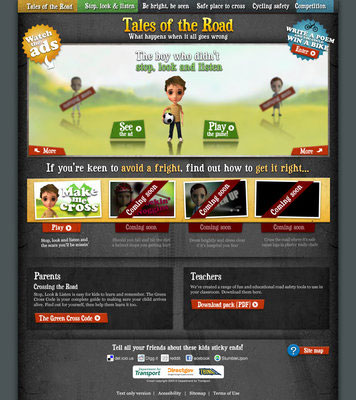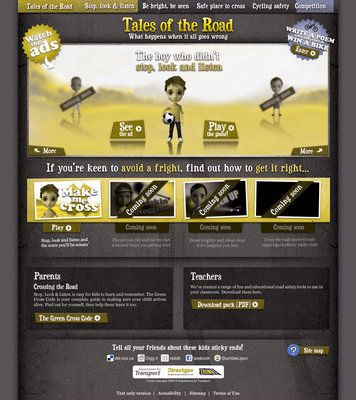Accessibility
Accessibility Statement
Tales of the Road is committed to providing a website that is accessible to the widest possible audience, regardless of technology or ability. We are actively working to increase the accessibility and usability of our website and in doing so adhere to many of the available standards and guidelines.
Web Accessibility Initiative
This website endeavours to conform to level Triple-A of the World Wide Web Consortium (W3C) Web Content Accessibility Guidelines 1.0. These guidelines explain how to make web content more accessible for people with disabilities. Conformance with these guidelines will help make the web more user friendly for all people.
W3C Standards
This site has been built using code compliant with W3C standards for XHTML and CSS. The site displays correctly in current browsers and using standards compliant XHTML/CSS code means any future browsers will also display it correctly.
Exceptions
Whilst Tales of the Road strives to adhere to the accepted guidelines and standards for accessibility and usability, it is not always possible to do so in all areas of the website. We are continually seeking out solutions that will bring all areas of the site up to the same level of overall accessibility. In the meantime should you experience any difficulty in accessing the Tales of the Road website, please don't hesitate to contact us.
Background Colours
In the text only version it is also possible to alter the background colour. This can be helpful for some people who find it difficult to white text on a dark background. You can access these alternatives in the links below and at the bottom of every page on this website by clicking on "Text only version"
Access keys and Tab Index
In Internet Explorer (6 & 7) the access keys are used by holding down the ALT key and pressing the access keys listed below, then pressing "ENTER" or "RETURN".
In the Windows versions of Firefox (1.5 & 2) the access keys are used by holding down the ALT + SHIFT keys and pressing the access keys listed below.
In OS-X on the Mac, Firefox 2 and Safari access keys are used by holding down the CTRL key and pressing the access key.
Opera in both Windows and OS-X does not seem to respond to the access keys.
You should also be able to Tab through all the links on a page using the TAB key
0 - Accessibility- a - Text only version
- c - Skip to content
- n - Skip to navigation
- 1 - Home
- 2 - Stop Look and Listen Game
- 3 - Be Bright. Be Seen Game
- 4 - Safer Place to Cross Game
- 5 - Fix'n'Ride Cycling Game
- 7 - Trophy Zone
- 8 - Grownups
- 9 - Contact Us
- m - Site Map
- u - Terms of Use
- t - Terms and Conditions
Colours
The design of the web page has been tested with Vischeck to ensure that it is possible to view the site with three different types of colour blindness.
This is the view of the web site main page with no distinct colour blindness

This web site as seen by somebody with Deuteranope colour blindness

This web site as seen by somebody with Protanope colour blindness

This web site as seen by somebody with Tritanope colour blindness (very rare)

Web Browsers and Operating Systems
The web sites have been checked with a number of Web Browsers and under a number of Operating Systems, including Internet Explorer 6 and 7, Opera 9, Firefox 1.5 and 2, Safari under OS-X and Konqueror in Suse Linux.
Internet Explorer
You can increase the font size (or reduce it) via the View and Text Size menu. Although all style sheets on this site will allow you to alter the font size, it is recommended that you do only if you use the Text only version of this site.
You can switch off all colours, fonts, and use your own style sheet under Tools, Internet Options, on the 'general' tab by pressing the 'Accessibility' button at the bottom. This option is not recommended for this site.
Firefox
You can make the text bigger by holding down the CTRL key and pressing the "+" (plus) key and smaller by holding down the CRTL key and pressing the "-" (minus) key
Opera Version 9.02
You can 'Zoom in' on the web pages by clicking on the View Menu and Zoom. The alterante stylesheets provided by the Opera browser are not recommended for this site.
Safari
You can make the text bigger by holding down the APPLE key and pressing the "+" key and smaller by holding down the APPLE key and pressing -
Google Chrome
You can make the text bigger by holding down the CTRL key and pressing the "+" (plus) key and smaller by holding down the CRTL key and pressing the "-" (minus) key
Resizing fonts
You can increase the font size (or reduce it) via browser setting described above. Although all style sheets on this site will allow you to alter the font size, for more extreme resizing of fonts (more than 3 times original size) it is recommended you use the text only version of this site.
No images settings in browsers
If you wish to browse this website with the images switched off in your browser settings, we recommend that you use the text only version of the website
More information regarding Accessibility
More information on how to modify your web experience on your own computer you may find the BBC webpages on accessibility useful.
Apple have built a number of accessibility features into their operating system. Find out more about Apple Accessibility.
XHTML, CSS and AAA Accessibility
It is the intention that all the web pages on this site conform to these standards. If they do not, please email the webmaster (access key 9) and we will correct the problem if possible.
Accessibility Plan
The Tales of the Road (TOTR) website team endeavour to develop and maintain accessible and usable online content. This will ensure that:
- Online content is as inclusive and usable as possible
- Legal requirements under the Disability Discrimination Act (1995/2005) are met
Policy intention
This policy identifies clear accessibility principles that content on the Tales of the Road website (www.direct.gov.uk/talesoftheroad) should follow. Policy timetable.
A multi-faceted timetable for improving the accessibility of new, existing and legacy online content has been adopted:
- All new online content will comply with online accessibility standards
- All reasonable efforts will be taken to ensure that existing online content complies with online accessibility standards - priority will be given to improving key documents and popular (highly visited) sections of the TOTR website
Online content formats
Online content will primarily be published on the TOTR website as extensible hypertext markup language (XHTML) files that use cascading style sheets (CSS). A text-only version of this website is accessible at the bottom of every page on this website by clicking on "Text only version".
Exceptions
The TOTR website has some online content that can not be provided in XHTML. Where non-XHTML formats are used:
- Files will be created in accordance with the accessible authoring techniques available for these formats
- All reasonable efforts will be taken to provide alternative accessible versions
- Contact details will be provided for the supply of alternative non-web formats
Situations where online content may be provided in non-XHTML formats include:
- Content with technical restrictions or legal requirements
- Online versions of hardcopy publications
- Content in online databases and applications
Conformance with web and online accessibility standards
Online content on the TOTR website will confirm to world best practice web and accessibility standards and guidelines published by the:
- World Wide Web Consortium (W3C)
- Web Accessibility Initiative (WAI)
- United Kingdom Government Central Office of Information (COI)
- Creators of propriety software (e.g. Adobe, Microsoft etc)
In particular, the TOTR team will continuously take all reasonable steps to ensure that its online content complies with:
- Conformance levels A (priority level 1) and AA (priority level 2) of the Web Content Accessibility Guidelines (WCAG) 1.0
- United Kingdom Government web standards and guidelines
- COI guidance TG102 delivering inclusive websites
- COI guidance TG109 minimum technical standards
- COI guidance TG110 making PDF files usable and accessible
- XHTML 1.0 the extensible hypertext markup language (second edition) specification
- Cascading style sheets level 2 revision 1 (CSS 2.1) specification
- Accessible authoring techniques available for all propriety software:
- Adobe PDF and Flash
- Microsoft Office
Checking conformance with web and online accessibility standards
Conformance checking against W3C/WAI and COI guidelines and specifications will be regularly carried out by DfT. The technical and usable accessibility of online content on the TOTR website will be checked using:
- Automated testing and validation
- Manual checks
- Assistive technology tool testing
- User testing with people from a range of disabilities, preferences and ages
- Expert reviews and conformance inspections of representative samples of web pages
Accessibility testing timetable
The TOTR team will use a combination of various testing techniques to test for accessibility compliance. In particular, testing will be carried out at four key stages throughout the website's design lifecycle:
- Requirements gathering
- Design
- Build
- Maintenance
Accessibility user testing profiles
Disabilities to be considered during the development and redevelopment of content on the TOTR website may include:
- Vision impairment
- Mobility problems
- Cognitive and learning problems
- Hearing loss
Consideration will also be given to other users who will benefit from improved online accessibility, including
- People with slow internet connections
- People with low bandwidth quotas
- People using hand-held mobile internet-enabled devices
- People with English as a second language
- People from different cultural and socio-economic backgrounds
- People from different generations
Accessibility user testing techniques and technologies
A combination of techniques and adaptive technologies that disabled users may employ will be tested, including:
- Screen reader and text-to-speech software
- Keyboard only operation
- Adaptive hardware and input devices
- Changing text size and formatting
Accessibility across different operating systems, internet-enabled hardware and web browsers will also be tested.
Accessibility user testing tasks
Accessibility user testing will involve completing core tasks that users should be able to achieve on the TOTR website. The criteria for determining the success of accessibility user testing of the TOTR website include:
- Effectiveness
- Efficiency
- Satisfaction
Contacts
For further information about the TOTR online accessibility policy please contact:
TOTR Website Manager
Department for Transport
Communication Directorate
Floor 5, Zone 5/04, Great Minster House
76 Marsham Street, London, SW1P 4DR, UK
phone 020 7944 4739, fax 020 7944 9643
dftpublicity@dft.gsi.gov.uk

